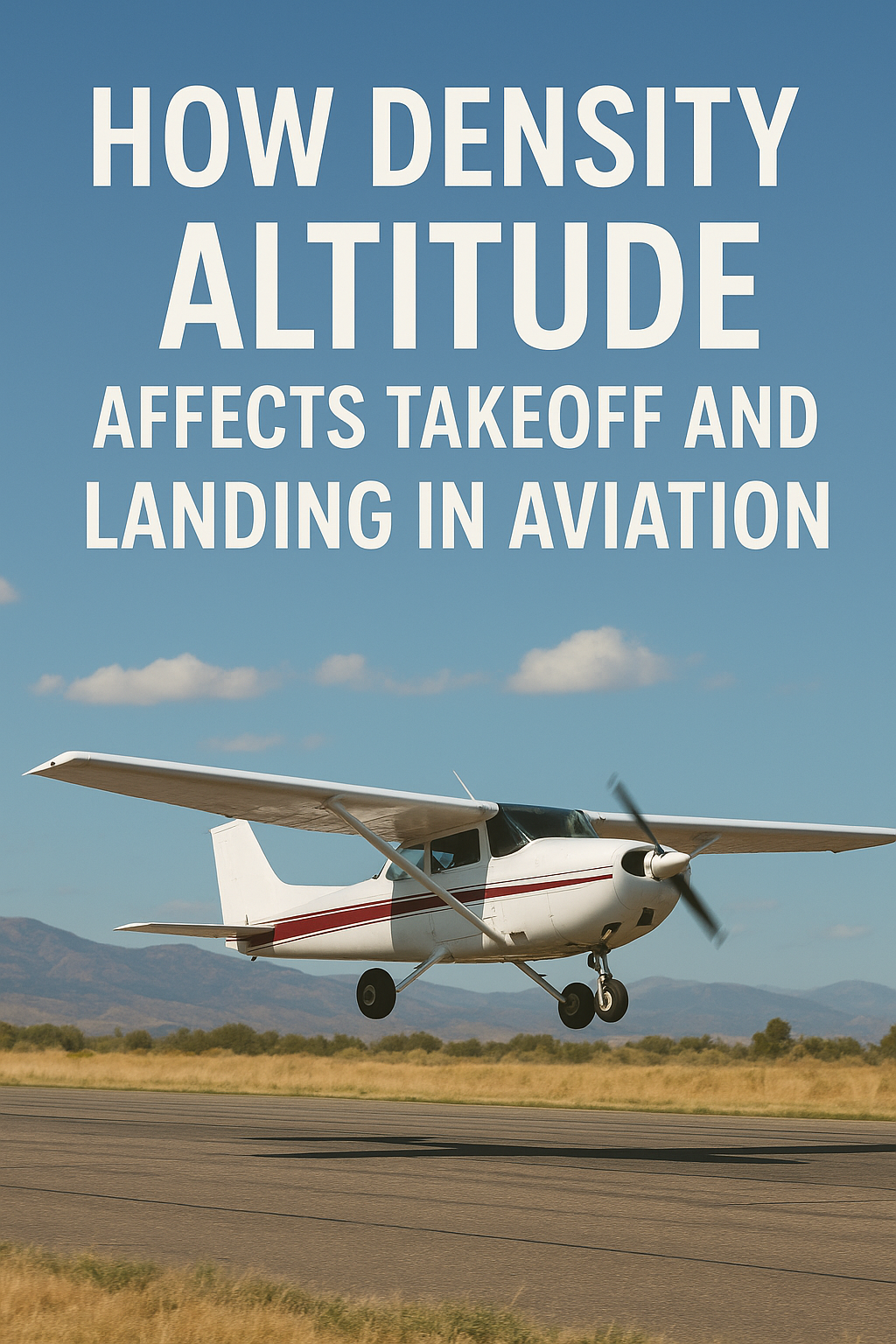
How Density Altitude Affects Takeoff and Landing in Aviation
By Ed Hoekstra, CFI/CFII
As a Certified Flight Instructor (CFI), I want to spend some time today talking about a concept that often confuses new student pilots: density altitude. Understanding how density altitude affects takeoff and landing performance is not just an academic exercise—it’s one of those life-saving lessons every pilot needs to grasp early.
Think of density altitude as the “hidden thief” in aviation. You can’t see it, you can’t touch it, but it has a very real effect on how your airplane performs. When the conditions are right (or wrong), density altitude can make a 5,000-foot runway feel like only 3,000 feet, and it can turn a routine departure into a marginal one. Let’s break it down in a way that’s clear, practical, and most importantly—useful for your everyday flying.
What Is Density Altitude?
In simple terms, density altitude is pressure altitude corrected for non-standard temperature. It’s a way of expressing how “thick” or “thin” the air feels to your airplane. The higher the density altitude, the thinner the air.
Here’s what makes it rise:
-
High elevation airports (like those in Colorado or New Mexico) already start with thinner air.
-
Hot temperatures thin the air even more.
-
High humidity adds to the effect, though it’s less significant than temperature and pressure.
When we put all three together—high, hot, and humid—we get the classic “three H’s” that create dangerously high density altitude.
Why Density Altitude Matters
Airplanes need air molecules to fly. Your wings generate lift by pushing against air, and your propeller produces thrust by grabbing that same air. When the air is thin, you get less lift and less thrust.
That affects your flying in three critical ways:
-
Takeoff Distance Increases – Your airplane needs a longer ground roll to reach rotation speed.
-
Climb Rate Decreases – Once airborne, you won’t climb as quickly or as steeply.
-
Landing Roll Increases – With less drag and thinner air, your aircraft takes longer to slow down after touchdown.
As a student pilot, you might first notice density altitude on hot summer days. The airplane feels “sluggish,” like it’s just not eager to get off the ground. That’s density altitude in action.
Takeoff Performance and Density Altitude
Picture yourself at a high-elevation airport like Leadville, Colorado (the highest public-use airport in North America at 9,934 feet). On a crisp winter morning, your airplane leaps off the runway without much effort. But on a 90°F July afternoon, the same airplane might struggle to get airborne before the pavement ends.
Why? Because on that hot day, the density altitude could be equivalent to 12,000 feet or higher. That means your engine is developing less horsepower, your propeller is less efficient, and your wings need a much higher true airspeed to generate lift.
This is why we always teach student pilots to consult the performance charts in the Pilot’s Operating Handbook (POH). Those charts show you exactly how much runway you’ll need for a given weight, elevation, and temperature. Ignoring them is not just sloppy flying—it’s dangerous.
Practical tip for student pilots: On hot days, calculate your takeoff distance carefully and always add a safety margin. If the numbers are tight, consider reducing weight (less fuel or baggage), departing in the early morning, or simply postponing the flight.
Landing Performance and Density Altitude
Many student pilots focus on takeoff performance but underestimate the effect of density altitude on landing. But it matters—sometimes just as much.
At a high density altitude:
-
Your true airspeed will be higher for the same indicated approach speed.
-
That higher groundspeed means you’ll float longer in ground effect.
-
Your rollout distance will increase because you’re carrying more kinetic energy down the runway.
Let’s say you normally approach at 65 knots indicated. At a high density altitude airport, that 65 knots indicated could equal 75–80 knots true. That extra speed translates into a longer landing distance—sometimes hundreds of additional feet.
Practical tip for landings: Be precise with your airspeeds, plan for a longer rollout, and avoid short or obstructed runways when density altitude is high.
How to Calculate Density Altitude
You don’t need to be a math wizard. Most flight planning apps and avionics calculate density altitude automatically. But every student pilot should know how to estimate it manually:
-
Start with pressure altitude (set your altimeter to 29.92 and read the altitude).
-
Add 120 feet for every degree Celsius above standard temperature (ISA).
For example:
-
Airport elevation = 5,000 feet
-
Standard temp at 5,000 feet = 5°C
-
Actual temp = 25°C (20° above standard)
-
Correction = 20 × 120 = 2,400 feet
Density altitude = 7,400 feet.
That’s the altitude your airplane “thinks” it’s operating at.
Real-World Examples
-
Case 1: Student Pilot in Arizona – A Cessna 172 at Prescott (5,000 feet elevation) on a 95°F day. Density altitude can easily exceed 9,000 feet. Expect sluggish acceleration and poor climb performance.
-
Case 2: Mountain Flying in Colorado – Departing a 7,000-foot airport on a warm afternoon. Even a light airplane may struggle to outclimb surrounding terrain. Morning departures are much safer.
-
Case 3: Flatlands in Summer – Even airports at 1,000 feet elevation can see density altitudes of 3,000–4,000 feet on hot, humid days. It matters everywhere, not just in the mountains.
Tips for Student Pilots to Stay Safe
-
Do Your Performance Calculations – Don’t guess. Use your POH and add a margin.
-
Fly Early or Late – Morning air is cooler and denser. Afternoon heat is your enemy.
-
Watch Your Weight – Heavy airplanes suffer more from density altitude. Leave behind unnecessary baggage.
-
Use All Available Runway – Don’t try to save taxi time. Every foot counts.
-
Have an Abort Point – Decide before the roll when you’ll reject the takeoff if you’re not airborne.
A CFI’s Final Thoughts
As an instructor, I want you to view density altitude not as a scary concept, but as an important tool in your decision-making kit. Many pilots get into trouble not because they didn’t understand it, but because they didn’t respect it.
Every takeoff and landing is a math problem you can solve. With practice, you’ll get good at spotting the days when your airplane is trying to whisper to you: “Not today, not under these conditions.” Listen to it.
High density altitude has been a contributing factor in countless accidents, especially in general aviation. But the good news is, as a well-trained pilot, you have the knowledge to recognize the hazard, plan accordingly, and keep yourself and your passengers safe.
So the next time you step into the cockpit on a hot summer afternoon, pause for a moment. Ask yourself: What’s the density altitude today, and what does it mean for my takeoff and landing? That simple habit might one day make all the difference.
By Ed Hoekstra, CFI/CFII
If you’re a student pilot looking for helpful study tools and flight gear, NorthstarVFR.com is a trusted resource designed with your training in mind. We offer carefully curated pilot supplies and study materials, including our popular Pre-Tabbed FAR/AIM, Oral Exam Guides, kneeboards, logbooks, and more. Everything is selected to help you stay organized, pass your checkrides, and fly with confidence. Check it out and set yourself up for success in the cockpit.
